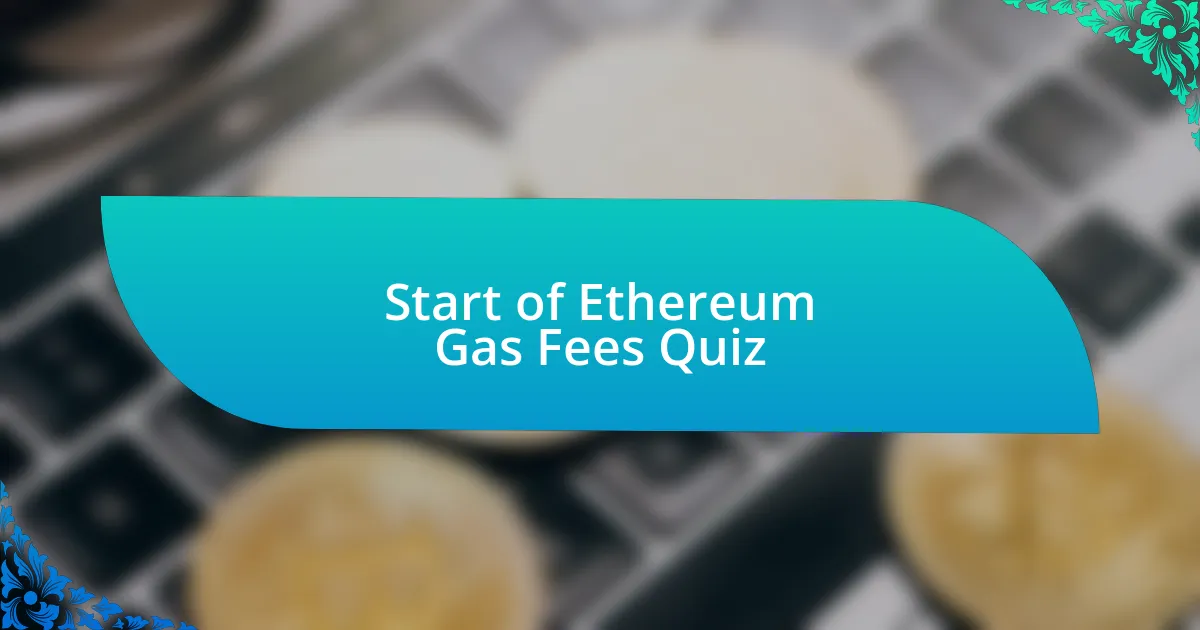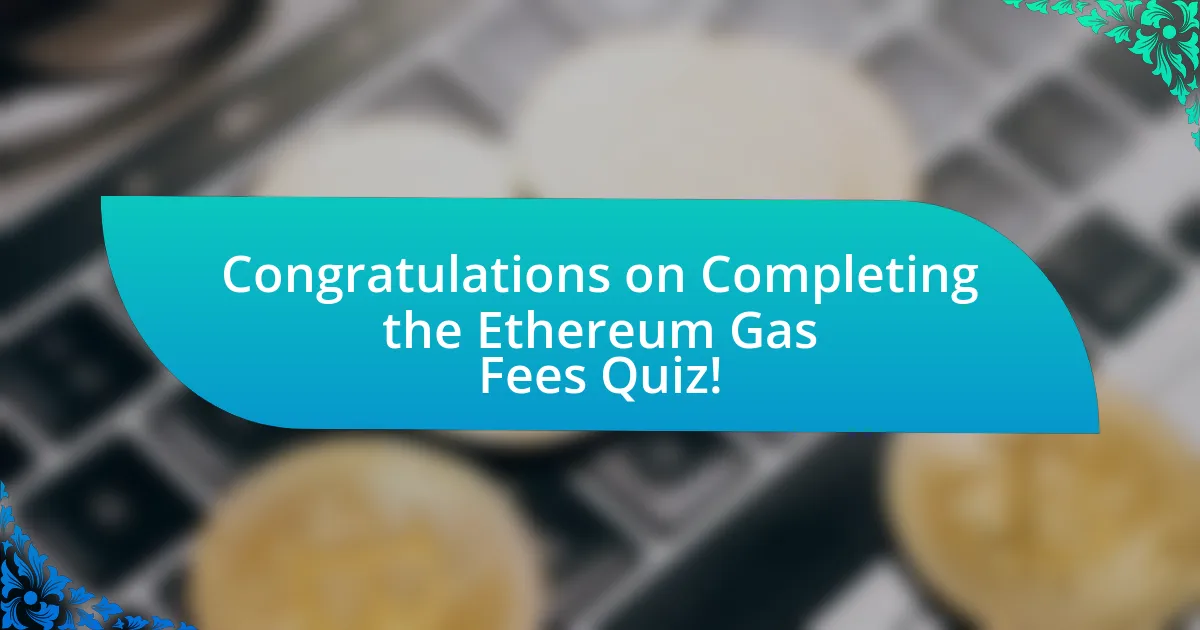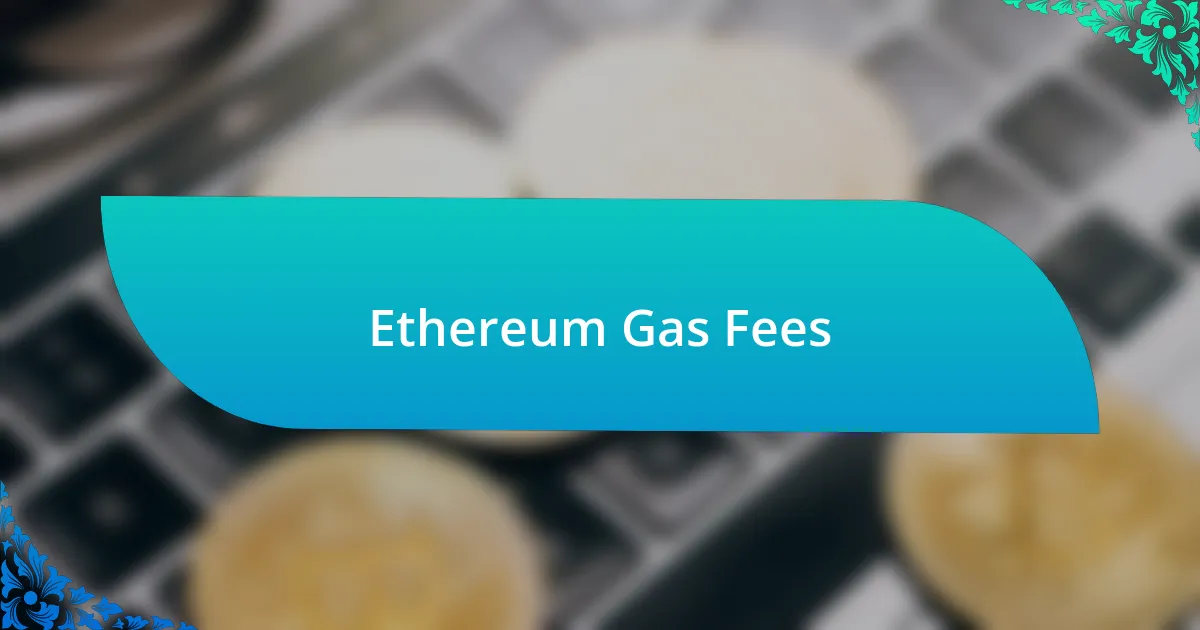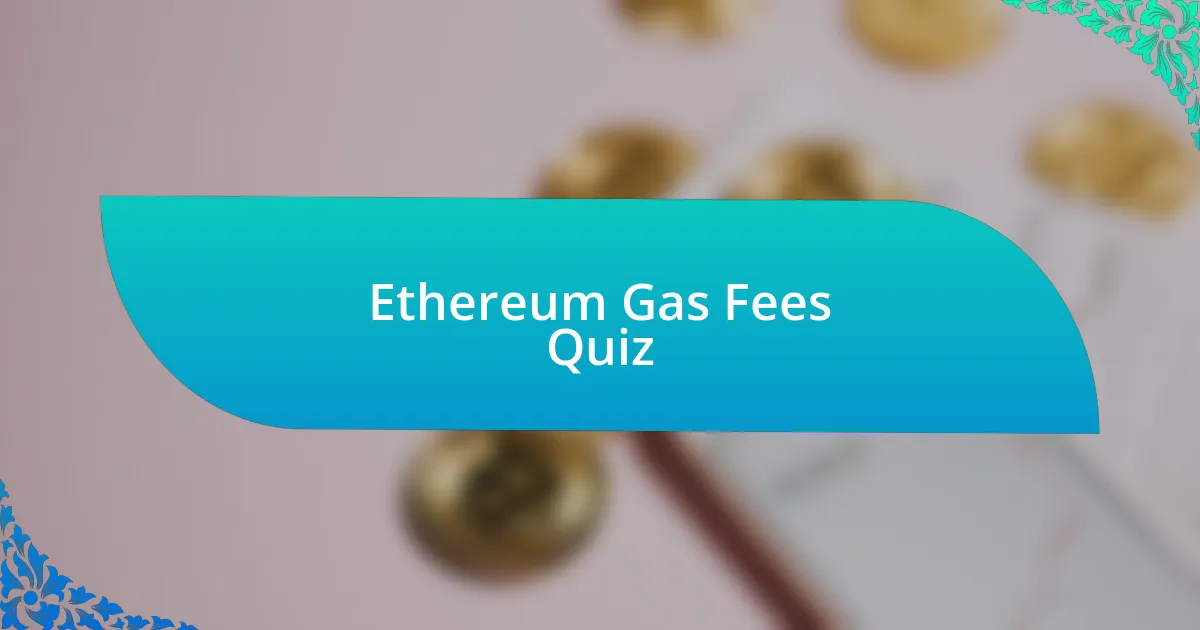
Start of Ethereum Gas Fees Quiz
1. What is gas in the context of Ethereum?
- Gas is a type of cryptocurrency used for trading on exchanges.
- Gas refers to the storage capacity of an Ethereum wallet.
- Gas is the fee required to successfully conduct a transaction or execute a contract on the Ethereum blockchain platform.
- Gas is the temperature control for Ethereum miners.
2. How are gas fees priced?
- Gas fees are priced in tiny fractions of the cryptocurrency ether (ETH) called gwei.
- Gas fees are based on the current price of Bitcoin (BTC).
- Gas fees are fixed rates set by the Ethereum Foundation.
- Gas fees are determined solely by the transaction history of the sender.
3. What is the purpose of gas fees?
- Gas fees are used to create new cryptocurrencies.
- Gas fees are used to buy tokens on exchanges.
- Gas fees are used to pay validators for the resources needed to conduct transactions.
- Gas fees are used to store data on the blockchain.
4. How is the exact price of gas determined?
- The exact price of gas is determined by government regulations only.
- The exact price of gas is determined by the daily average price of oil.
- The exact price of gas is determined by the number of users online.
- The exact price of gas is determined by supply, demand, and network capacity at the time of the transaction.
5. What are the key takeaways about gas fees on Ethereum?
- Gas fees on Ethereum are fixed and do not change based on demand or network conditions.
- Gas fees are only applicable to trading cryptocurrencies on Ethereum, not for contract execution.
- On the Ethereum blockchain, gas refers to the cost necessary to perform a transaction on the network. Gas prices are based on supply and demand for the network`s validation requests. Transaction prices are based on the gas limit and gas price.
- Gas prices are determined solely by the Ethereum foundation without any market influence.
6. How do gas fees work before the London upgrade?
- Gas fees were calculated based on a flat rate set by miners.
- Gas fees were calculated as: Gas fee = Gas units (limit) * Gas price per unit.
- Gas fees were determined solely by the total number of transactions.
- Gas fees were a fixed amount regardless of usage.
7. How do gas fees work after the London upgrade?
- Gas fees are calculated using the formula: Gas fee = Gas units (limit) * (base fee + priority fee).
- Gas fees are calculated using the formula: Gas fee = Gas units (limit) * Gas price per unit.
- Gas fees are fixed and do not vary based on network conditions.
- Gas fees are primarily influenced by the total amount of ether in circulation.
8. What is the base fee in gas fee calculation after the London upgrade?
- A set fee for transactions
- A variable fee paid to miners
- A fluctuating fee based on demand
- A flat fee for network maintenance
9. What is the priority fee in gas fee calculation after the London upgrade?
- The priority fee is an extra charge for failed transactions.
- The priority fee is a tip to the validator that chooses a transaction.
- The priority fee is a mandatory charge for all transactions.
- The priority fee is a fixed fee set by the network.
10. How does the priority fee affect transaction processing time?
- The priority fee makes transactions more attractive for validators to process quickly.
- The priority fee decreases the transaction processing speed significantly.
- The priority fee only applies to high-value transactions and ignores others.
- The priority fee has no impact on the transaction speed at all.
11. What happens if you set your gas limit too low?
- You will receive a refund for the unused gas limit.
- Your transaction will process as normal with no issues.
- Your transaction may fail, and you`ll lose the fee.
- Your transaction will complete but be delayed significantly.
12. What happens if you set your gas limit too high?
- You will lose all your gwei and the transaction will fail.
- Your transaction will be prioritized and processed immediately.
- If you set your gas limit too high, you will receive a refund for the excess gwei.
- You will have to wait longer for your transaction to complete.
13. How do you minimize Ethereum gas fees?
- You can minimize Ethereum gas fees by using a specific cryptocurrency wallet.
- You can minimize Ethereum gas fees by increasing your transaction speed.
- You can minimize Ethereum gas fees by transacting during low-traffic times.
- You can minimize Ethereum gas fees by setting a higher gas price.
14. What is lazy minting in the context of NFTs?
- Lazy minting refers to the annihilation of NFTs after transactions.
- Lazy minting means automatic resale of NFTs without creator fees.
- Lazy minting is a method to permanently lock NFTs from being changed.
- Lazy minting allows NFT creators to delay costs until the NFT is sold.
15. When are gas fees generally cheaper?
- Gas fees are generally cheaper during weekdays.
- Gas fees are generally cheaper on weekends and nights.
- Gas fees are generally cheaper on holidays.
- Gas fees are generally cheaper in the morning.
16. How do wallets like MetaMask help in managing gas fees?
- Wallets ignore the network conditions when processing transactions.
- Wallets like MetaMask charge a flat fee for all transactions.
- Wallets automatically select gas prices for users without options.
- Wallets like MetaMask allow users to set transaction speeds to manage fees.
17. What is the relationship between gas costs and the blockchain used?
- Gas costs relate to the blockchain`s consensus mechanism.
- Gas costs are determined solely by user experience.
- Gas costs remain constant regardless of blockchain.
- Gas costs have no impact on transaction speed.
18. How are gas fees calculated on Hedera?
- Gas fees on Hedera are calculated using a single flat rate for all transactions.
- Gas fees on Hedera are based solely on the amount of tokens transferred.
- Gas fees on Hedera are fixed and do not change.
- Gas fees on Hedera are calculated by adding intrinsic gas, EVM operation gas, and Hedera service gas.
19. Why are Ethereum gas fees higher than those on other blockchains?
- Ethereum uses a single blockchain without any additional layers.
- Ethereum transactions are always processed at the same speed regardless of demand.
- Ethereum operates on a fixed transaction fee structure for all users.
- Ethereum has a complex network that supports diverse applications.
20. What is the formula to calculate gas fees on Ethereum?
- Gas fee = Gas units (limit) / (base fee + priority fee)
- Gas fee = Gas units (limit) * Gas price
- Gas fee = Gas units (limit) + base fee + priority fee
- Gas fee = Gas units (limit) * (base fee + priority fee)
21. What is the default gas limit for simple Ethereum transactions?
- 30,000
- 21,000
- 15,000
- 50,000
22. How do you calculate the gas fee for a transaction?
- To calculate the gas fee, divide the gas limit by the gas price and then convert the result to ETH.
- To calculate the gas fee, add the gas limit and the gas price and then convert the result to ETH.
- To calculate the gas fee, multiply the gas limit by the gas price and then convert the result to ETH.
- To calculate the gas fee, subtract the gas limit from the gas price and then convert the result to ETH.
23. What happens if you don`t pay enough in gas for a transaction?
- The gas fee will be automatically refunded.
- The user will be charged an additional fee for the delay.
- The transaction will be completed without any issues.
- The transaction may not be processed promptly and successfully.
24. How do layer 2 solutions affect gas fees?
- Layer 2 solutions can help reduce gas fees by taking transactions off the main chain.
- Layer 2 solutions increase gas fees by adding more transactions to the main chain.
- Layer 2 solutions have no effect on gas fees during high network activity.
- Layer 2 solutions make gas fees more unpredictable and complex.
25. What is the effect of network congestion on gas fees?
- Network congestion has no effect on gas fees regardless of transaction volume.
- Network congestion eliminates gas fees entirely during peak times.
- Network congestion decreases gas fees due to fewer transactions being processed.
- Network congestion increases gas fees because there are more transactions to validate.
26. How do you estimate a reasonable gas limit?
- You can only set gas limits based on personal experience.
- You can estimate a reasonable gas limit by looking at the current or weekly gas price averages.
- You must pay the maximum fee to set any gas limit.
- You estimate it by selecting the highest fee available.
27. What is the role of validators in the Ethereum network?
- Validators store user data and maintain personal wallets on the network.
- Validators perform essential tasks such as verifying and processing transactions on the Ethereum network.
- Validators only create smart contracts and do not handle transactions.
- Validators mine new Ethereum blocks and govern changes in the network.
28. How do validators get rewarded in the Ethereum network?
- Validators earn rewards through transaction fees paid by users directly.
- Validators are rewarded with a portion of the gas fee for their work in maintaining and securing the blockchain.
- Validators receive a fixed bonus payment regardless of their activities.
- Validators are rewarded with new Ethereum coins minted for each block.
29. What is the difference between proof-of-work and proof-of-stake in terms of gas fees?
- Proof-of-work and proof-of-stake have the same gas fees.
- Proof-of-stake has no impact on gas fees at all.
- Proof-of-work has lower gas fees due to system efficiency.
- Proof-of-work has higher gas fees due to mining requirements.
30. How has the switch from proof-of-work to proof-of-stake affected gas fees on Ethereum?
- The switch from proof-of-work to proof-of-stake has led to a gradual decrease in gas fees over time.
- The switch from proof-of-work to proof-of-stake has no effect on gas fees at all.
- The switch from proof-of-work to proof-of-stake has made gas fees completely free.
- The switch from proof-of-work to proof-of-stake has caused gas fees to triple instantly.

Congratulations on Completing the Ethereum Gas Fees Quiz!
You’ve just wrapped up an informative journey into the world of Ethereum gas fees. We hope you enjoyed the process and found the quiz engaging. Understanding gas fees is crucial for anyone interested in Ethereum, as it affects transactions and smart contracts. You likely learned about how fees are calculated, what factors influence them, and why they fluctuate. This knowledge can empower you to manage your transactions more effectively.
Quizzes like this not only test your knowledge but also reinforce what you’ve learned. By answering the questions, you’ve solidified your understanding of key concepts. You may now have a clearer picture of how the Ethereum network operates and why gas fees are an essential part of it. This knowledge is vital for navigating the blockchain space with confidence.
To deepen your understanding of Ethereum gas fees even further, we invite you to explore the next section on this page. There, you’ll find comprehensive information that will expand on what you’ve learned. Detailed explanations, examples, and insights await you. Dive in and discover more about this fascinating aspect of Ethereum!

Ethereum Gas Fees
Understanding Ethereum Gas Fees
Ethereum gas fees are payments made by users to compensate miners for the computational energy required to process transactions on the Ethereum network. These fees are essential for incentivizing miners to validate and confirm transactions. Gas fees are measured in Gwei, which is a subdivision of Ethereum, where 1 Gwei equals 0.000000001 ETH. Higher gas fees often correlate with network congestion, as users compete to have their transactions processed promptly.
Components of Ethereum Gas Fees
The gas fee consists of two main components: gas limit and gas price. The gas limit indicates the maximum amount of gas a user is willing to spend on a transaction, while the gas price reflects how much a user is willing to pay per unit of gas. Together, these elements determine the total transaction fee. A higher gas limit may be necessary for complex transactions, such as those involving smart contracts.
Factors Influencing Ethereum Gas Fees
Several factors influence Ethereum gas fees, including network congestion, time of day, and the complexity of the transaction. When the network experiences high activity, gas fees increase as users bid higher amounts to prioritize their transactions. Additionally, peak usage times can result in elevated fees. The transaction complexity also affects fees, as operations requiring more computation consume more gas.
How to Estimate Ethereum Gas Fees
Estimating Ethereum gas fees can be done using various online tools and calculators. Websites like Ether Gas Station provide real-time data on current gas prices and suggest optimal gas limits for different transaction types. Users can also check the average historical gas prices to make informed decisions regarding their transactions. Monitoring these resources helps users select the appropriate gas price for timely processing.
Impact of Ethereum Improvement Proposals on Gas Fees
Ethereum Improvement Proposals (EIPs), particularly EIP-1559, have significantly impacted gas fees. EIP-1559 introduced a base fee that adjusts dynamically according to network demand. This change aims to make fees more predictable and efficient. As a result, users can better anticipate their costs, reducing the incidence of overpaying or experiencing delays due to high congestion.
What are Ethereum Gas Fees?
Ethereum gas fees are charges users pay to facilitate transactions or execute smart contracts on the Ethereum blockchain. Gas is measured in units, with one unit equal to a gas price in gwei, a denomination of ether. The fees compensate miners for the computational energy required to process and validate transactions. For instance, on average, gas fees can vary significantly based on network congestion; in mid-2021, they soared to over $70 for a standard transaction during peak usage, highlighting the fees’ volatility.
How are Ethereum Gas Fees calculated?
Ethereum gas fees are calculated by multiplying the amount of gas used for a transaction by the gas price set by the user. Each operation in Ethereum’s virtual machine consumes a specified amount of gas. For example, a simple transfer of ether might require 21,000 gas units. If the gas price is set at 100 gwei, the total fee would be 2,100,000 gwei, or 0.0021 ether. Thus, both gas limit and gas price directly affect the final fee paid.
Where can I view current Ethereum Gas Fees?
Current Ethereum gas fees can be viewed on various blockchain explorers and analytics websites such as Etherscan, GasNow, or EthGasStation. These platforms provide real-time data on gas prices, allowing users to see current average fees for standard, fast, and instant transactions. For instance, Etherscan displays the average gas price in gwei and provides helpful charts for historical data, making it easy to track fee trends.
When do Ethereum Gas Fees increase?
Ethereum gas fees tend to increase during periods of high network congestion, often associated with spikes in transaction volume. This is common during events such as major token launches, network upgrades, or popular decentralized finance (DeFi) activities. For example, in May 2021, a surge in demand for NFT transactions led to gas fees soaring upwards of $200 as users competed to have their transactions processed quickly.
Who determines Ethereum Gas Fees?
Ethereum gas fees are primarily determined by users, who set the gas price they are willing to pay for transaction processing. Miners then prioritize transactions based on the gas prices attached; higher fees incentivize faster processing. Additionally, network demand and supply dynamics play a crucial role in shaping prevailing gas prices. For example, during peak times, average gas prices may rise significantly as more users queue for transaction execution.

